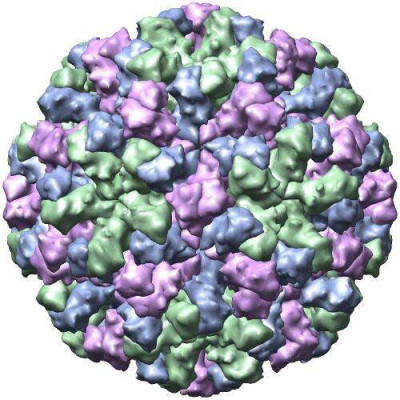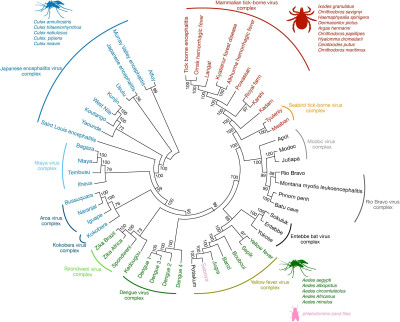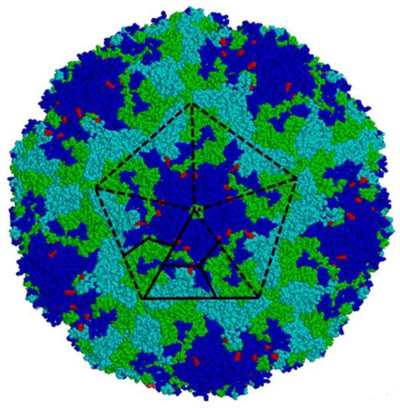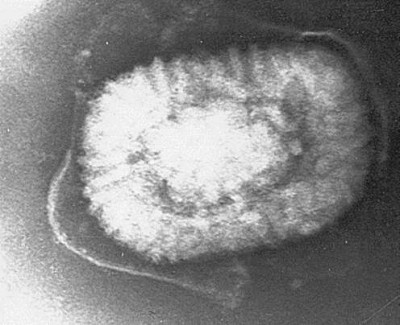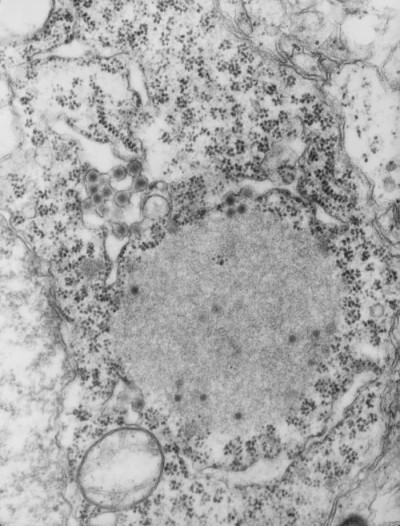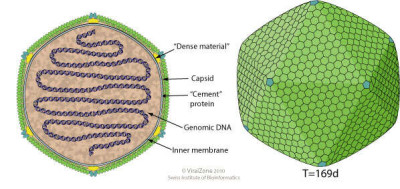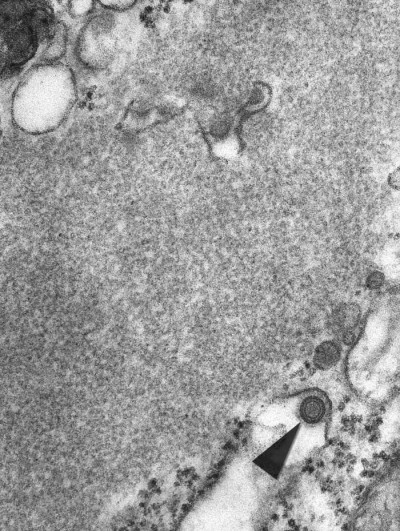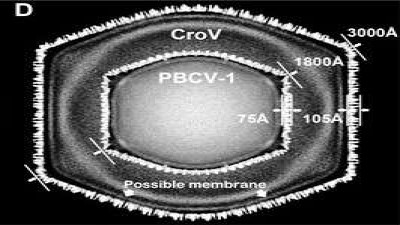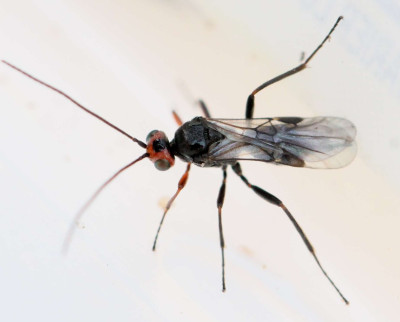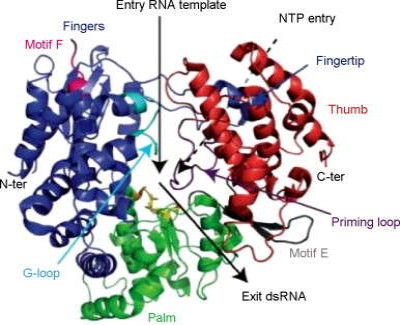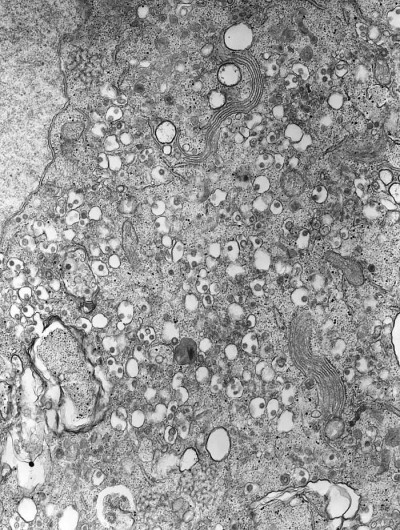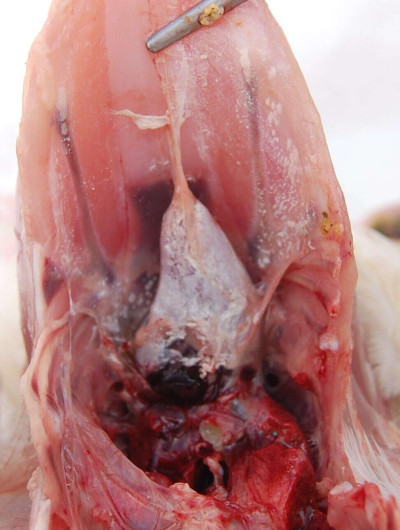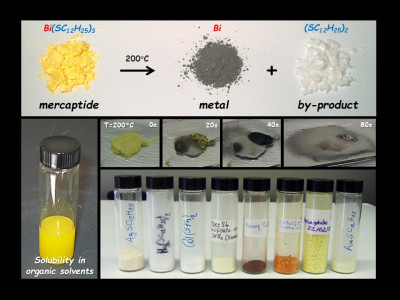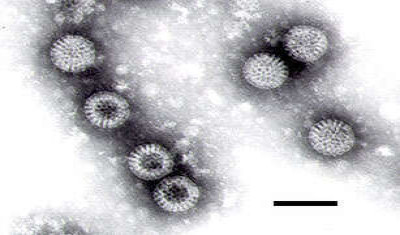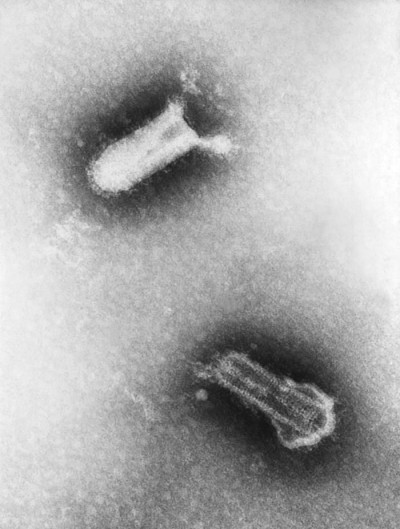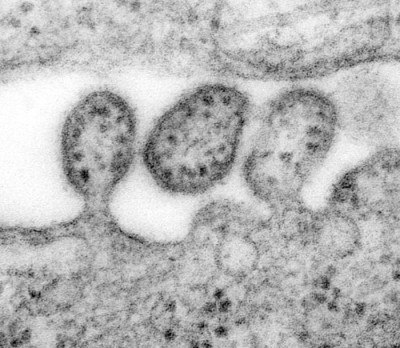X-ray crystallographic structure of the Norwalk virus capsid.
Prasad, B.V., Hardy, M.E., Dokland, T., Bella, J., Rossmann, M.G., Estes, M.K, Wikimedia Commons
01 Mar 2024
The antigenic relationships among flaviviruses. Phylogenetic analysis demonstrates that flaviviruses cluster not just antigenically but also group according to their known transmission vectors. Some of the most significant flaviviral human pathogens belong to the JEV, Spondweni, DENV, YFV, and mammalian TBV serocomplexes, respectively (arched lines cover viruses of the same serocomplex). Some of their most common vectors are also listed, such as the mosquito species Culex (blue) and Aedes (green) and various species of ticks (red). Other flaviviruses have no known vector, for example, viruses of the Modoc, Rio Bravo, and Entebbe bat virus complex (black). Among the Aedes mosquito-borne viruses of the YFV serocomplex, Saboya virus (pink) has been successfully isolated from the phlebotomine sand flies (85). Phylogenetic analysis was conducted using molecular evolutionary genetic analysis (MEGA-7) software (86). The full-length polyprotein amino acid sequences from various flaviviruses were obtained from the NCBI database and pairwise aligned using Clustal W. The phylogenetic tree was constructed by using the maximum likelihood method based on the Jones-Taylor-Thornton (JTT) matrix-based model (87). The consensus tree representing 200 bootstrap is presented (88). Branches that were reproduced in less than 50% bootstrap replicates are collapsed. The nodes show bootstrap support values from replicates.[1]
Wikimedia Commons, Abhay P. S. Rathore and Ashley L. St. John
02 Apr 2024
Enterovirus 71 (EV71) genotype A virus particle. VP1 (blue), VP2 (cyan), VP3 (green) and VP4 (yellow) proteins are presented in whole virus particle. [1]
Wikimedia Commons,Min-Yuan Chia, Wan-Yu Chung, Pai-Shan Chiang, Yeh-Sheng Chien, Mei-Shang Ho, and Min-Shi Lee
24 Jan 2024
Canine Distemper is a viral disease affecting animals in the canine families in addition to some other mammals. The raccoon may be thin and debilitated and diarrhea is a clear symptom. In the final stage of the disease, the raccoon may begin to wander aimlessly in a circle, disoriented and unaware of its surroundings, suffer paralysis or exhibit other bizarre behavior as a result of brain damage.[1]
This raccoon walked in circles for over an hour while the observer was at this location. [2]
iNaturalist, Lily M
01 Feb 2024
Myxoma virus is a poxvirus in the genus Leporipoxvirus. Myxoma virus is passively transmitted on the mouth parts of mosquitoes, (such as Aedes aegyptii) or fleas, and presumably other biting arthropods.
Wikimedia Commons
02 Feb 2024
Colorado Tick Fever (CTF) is a viral disease spread by the bite of an infected Rocky Mountain wood tick. Coltivirus particles are 80 nm in diameter and have a core 50 nm in diameter. Electron microscopic studies have shown particles with a relatively smooth capsomeric surface structure, and icosahedral symmetry.
Public Health Image Library
02 Feb 2024
Schematic drawing of a Phycodnaviridae virion (cross section and side view). Enveloped virion of which the membrane is surrounded by a capsid with an icosahedral symmetry (T=169), 120-150 nm in diameter. Dense material are present at each 5-fold symmetry vertex.
ViralZone, SIB Swiss Institute of Bioinformatics, Wikimedia Commons
22 Feb 2024
This transmission electron micrograph (TEM) revealed some of the internal cross-sectional structural morphology of a rabies virion (arrow) in this central nervous system tissue specimen. The virion is adjacent to a Negri body, which is pathognomonic in the positive diagnosis for Rabies. The virus infects the central nervous system, causing encephalopathy and ultimately death. Rabies virus belongs to the order Mononegavirales, viruses with a nonsegmented, negative-sense single-stranded RNA ((-) ssRNA) genomes. Within this group, viruses with a distinct "bullet" shape are classified in the Rhabdoviridae family, which includes at least three genera of animal viruses, Lyssavirus, Ephemerovirus, and Vesiculovirus. The genus Lyssavirus includes rabies virus, Lagos bat, Mokola virus, Duvenhage virus, European bat virus 1 & 2 and Australian bat virus.
Public Health Image Library
23 Feb 2024
Central cross-section of the cryo-electron microscopy map of Cafeteria roenbergensis virus (CroV) superposed with that of PBCV-1. CroV not only has a larger virion diameter (3000 Å vs 1800 Å), its capsid layer is also thicker (105 Å vs 75 Å).[1]
Chuan Xiao, Matthias G. Fischer, Duer M. Bolotaulo, Nancy Ulloa-Rondeau, Gustavo A. Avila, Curtis A. Suttle, Wikimedia Commons
23 Feb 2024
The Myxoma virus (MYXV) typically poses a common and nonfatal threat to forest rabbit populations in South America. In contrast, when European domestic rabbits contract the virus, it triggers a severe and frequently deadly illness characterized by the development of tumors, particularly in the head area, due to the rapid growth of connective tissue.
iNaturalist, A Emmerson
29 Feb 2024
The parasitic wasp known as Dinocampus coccinellae preys on coccinellid beetles, such as the spotted lady beetle Coleomegilla maculata.
iNaturalist
01 Mar 2024
Transcription and replication of the vesicular stomatitis virus (VSV) genome. (A) The negative-strand VSV genome in the N–RNA complex serves as a template for transcription (lower) and replication (upper). Le and Tr denote the terminal leader and trailer regions, respectively, in the genome. According to the single-entry, stop-start transcription model, the L–P RdRp complex enters from the 3′-end of the genome and sequentially synthesizes the leader RNA (LeRNA) and five monocistronic mRNAs with a 5′-cap 1 structure and 3′-poly(A) tail (lower). A GDP moiety (red) of GTP, an AMP moiety (blue) of ATP, and two methyl groups (green) are incorporated into the cap 1 structure. The L–P and N0–P (N0: RNA-free N) complexes are required for encapsidation-coupled genome replication (upper). (B) LeRNA is synthesized from the 3′-terminal of the Le promoter in the genome. The conserved gene-start and gene-end sequences serve as internal transcription initiation and termination/polyadenylation signals, respectively. The conserved 5′-terminal mRNA-start sequence acts as a signal for mRNA capping.
Wikimedia Commons, Tomoaki Ogino and Todd J. Green
01 Apr 2024
Overview of the flavivirus RdRp structure based on WNV NS5Pol [1] as an example; a “Front” view is presented here in ribbon representation. Fingers, palm and thumb subdomains are colored in blue, green and red, respectively. The ssRNA template entry and the dsRNA exit are shown by black arrows. A dotted arrow points to the NTP entry tunnel at the back of the RdRp. Motifs A, C, E, F, the G-loop and the priming loop are colored in orange, yellow, grey, magenta, cyan and purple, respectively. The Asp residues of catalytic motifs A and C (Asp-533, Asp-663 and Asp-664) are represented as stick models. N-ter and C-ter indicate the termini of the RdRp domain. [2]
Michela Bollati, Karin Alvarez, René Assenberg, Cécile Baronti, Bruno Canard, Shelley Cook, Bruno Coutard, Etienne Decroly, Xavier de Lamballerie, Ernest A. Gould, et al.
02 Apr 2024
This negatively-stained transmission electron micrograph (TEM) revealed the presence of numerous coronavirus virions in this tissue sample. Coronavirus is a member of the virus family, Coronaviridae, which at their core contain a positive-sense single-stranded RNA genome ((+) ssRNA). Under electronmicrographic examination, the envelope surrounding each virion is studded with a corona of points, hence the derivation of its name, which are actually proteinaceous in nature, and are outcroppings of its envelope's molecular structure. Coronaviruses infect mammals and birds with upper respiratory and gastrointestinal illnesses. The most well-known member of this virus family is the human coronavirus responsible for causing severe acute respiratory syndrome (SARS).
Public Health Image Library
02 Apr 2024
Infectious bursal disease, prevalent in young domestic chickens globally, results from the infectious bursal disease virus (IBDV). Symptoms encompass lethargy, watery diarrhea, disheveled feathers, and dehydration. While morbidity rates are typically high, mortality rates are generally low, yet certain virulent strains can cause mortality rates exceeding 60%. Diagnosis relies on macroscopic and microscopic lesions in the cloacal bursa, along with molecular identification of the viral genome.
Wikimedia Commons, Lucyin
02 Apr 2024
Mercaptides are metal salts of alkyl mercaptans (i.e., metallic thiolates, MeSR, with Me: metal, S: sulphur and R: alkyl group); they represent an extremely valuable class of thermolytic precursors for the generation of pure-metal clusters/nanoparticles and chalcogenide (sulphide) quantum-dots (QDs) in molten thermoplastic polymer matrices. In particular, noble-metal mercaptides (mercaptides of Au, Ag, Pd, Pt, etc.) thermally decompose to generate the corresponding zero-valent metal and an organic by-product (organic disulphide, R-S-S-R). Differently, other types of metallic mercaptides (i.e., mercaptides of transition metals, alkali metals, alkaline earth metals, etc.) give the chalcogenide (i.e., MexSy) as inorganic product plus an organic by-product (organic sulphide, R-S-R). The inorganic compound (metal or metal sulphide) is generated in the molten polymer in form of nanoscopic solid phase (iperfine powder). Depending on the conditions of the in situ precipitation (precursor concentration, thermal annealing temperature, type of polymeric matrix, etc.), atomic clusters, quantum-dots or nanoparticles can be obtained. Such chemical synthesis technique has allowed to investigate different unique properties of metals on the nanometric scale (surface plasmon resonance, superparamagnetism, plasmonic thermochromism, etc.) [1]. In addition to the polymeric nanocomposite preparation, metallic mercaptides can be thermally decomposed also in a pure form to generate cluster compounds (i.e., thiol-derivatized metal clusters, Mex(SR)y) and other types of sub-micronic structures, because of the presence of the thiolate ligand unities (RS-) and the possibility for the metal thiolate to form a variety of mesophases (e.g., columnar and lamellar mesophases).
09 Feb 2024
Molecular surfaces of Triatoma virus (TrV) and Cricket paralysis virus (CrPV; PDB entry 1b35). The individual proteins are coloured according to the following code: VP1, blue; VP2, green; VP3, red. The structures are on the same scale. TrV displays characteristic surface projections formed by VP1 and VP3 around the fivefold axes, while there is a depression at the twofold axes of TrV.[1]
Gaëlle Squires, Joan Pous, Jon Agirre, Gabriela S. Rozas-Dennis, Marcelo D. Costabel, Gerardo A. Marti, Jorge Navaza, Stéphane Bressanelli, Diego M. A. Guérinb, and Felix A. Reya
01 Apr 2024
Note the wheel-like appearance of some of the rotavirus particles. The observance of such particles gave the virus its name ('rota' being the Latin word meaning wheel). Bar = 100 nanometers.
Wikimedia Commons, F.P. Williams, U.S. EPA.
18 Apr 2024
This negatively-stained transmission electron micrograph (TEM) revealed the presence of two Piry virus virions. Note the bullet-like shape of the small 155nm x 162nm virions. Normally, under electron microscopic examination, the virions are observed as being discoidal or spheroidal in shape, and only rarely as bullet-shaped, as was the case here.
Public Health Image Library
16 Jan 2024
This highly magnified transmission electron micrograph (TEM) depicted some of the ultrastructural details of a number of Lassa virus virions adjacent to some cell debris. The virus, a member of the virus family Arenaviridae, is a single-stranded RNA virus, and is zoonotic, or animal-borne that can be transmitted to humans. The illness, which occurs in West Africa, was discovered in 1969 when two missionary nurses died in Nigeria, West Africa.
In areas of Africa where the disease is endemic (that is, constantly present), Lassa fever is a significant cause of morbidity and mortality. While Lassa fever is mild or has no observable symptoms in about 80% of people infected with the virus, the remaining 20% have a severe multisystem disease. Lassa fever is also associated with occasional epidemics, during which the case-fatality rate can reach 50%.
Public Health Image Library, C. S. Goldsmith
24 Jan 2024
 Encyclopedia
Encyclopedia
